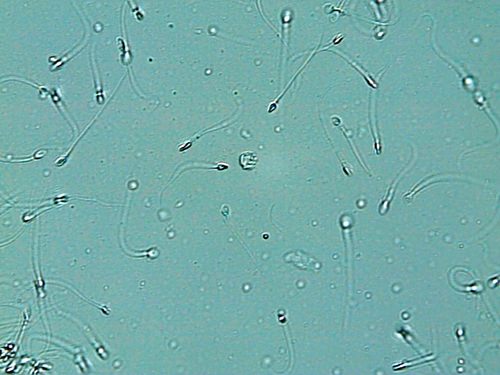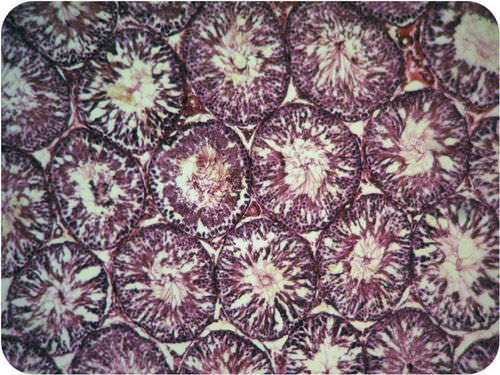17.78 精精度 - 高级
章节大纲
-
How many sperm does to take to fertilize an egg ?
::要用多少精子来给蛋施肥?85 million sperm are produced per day...per testicle. That's 170,000,000 every day. This means that a single male may produce more than a quadrillion (1,000,000,000,000) sperm in his lifetime! But it only takes one to fertilize an egg.
::每天产生8500万个精子...Production and Delivery of Sperm
::精子的生产和交付A sexually mature male typically produces several hundred million sperm per day. Sperm production usually continues uninterrupted until death, although the number and quality of sperm decline during later .
::性成熟的男性通常每天产生数亿个精子,精子生产通常持续到死亡为止,尽管精子的数量和质量在以后下降。Spermatogenesis
::子形起源Spermatogenesis is the process of producing mature sperm. Sperm are haploid cells, meaning they have half the number of that other cells of the body, which are diploid cells, have. Sperm must be haploid in order for normal to occur. During , a sperm unites with another cell, called an egg. This is called . Unless both sperm and egg are haploid, the resulting offspring will not have the diploid number of chromosomes.
::精子产生过程是生成成熟精子的过程。 精子产生是杂交细胞, 意思是它们拥有身体其他细胞的一半。 精子产生必须是杂交的, 以便正常发生。 精子产生过程中, 精子与另一个细胞结合, 称为蛋。 这被称为 。 除非精子和蛋都是杂交, 由此产生的后代不会拥有染色体的稀释数 。Sperm are produced in the seminiferous tubules of the testes and finish maturing in the epididymis . The entire process takes about 9 to 10 weeks. As shown in Table , the production of sperm occurs in several steps, each involving a different type of cell and process.
::精子在睾丸的精细管中产生,在结膜中完成成熟,整个过程大约需要9至10周,如表6所示,精子的生产分几个步骤进行,每个步骤涉及不同种类的细胞和工艺。Spermatogenesis begins when a spermatogonium (with the diploid number of chromosomes) undergoes to form primary spermatocytes (also with the diploid number of chromosomes). Spermatogenesis proceeds as a primary spermatocyte undergoes the first of to form secondary spermatocytes with the haploid number of chromosomes. A secondary spermatocyte undergoes the second meiotic cell division to form haploid spermatids . Spermatids mature into sperm, which are also haploid.
::当精子原子(包括染色体的低位数)形成初级精子细胞(也包括染色体的低位数)时,产生超子细胞的收益开始。 原始精子细胞细胞的生成过程首先形成次生精子细胞细胞,先形成次生精子细胞,次生精子细胞。次生精子细胞体经历第二微米细胞分解,形成手动精子。 精子发育成精子,后者也是杂交精子。A Seminiferous Tubule. This photograph shows an enlarged cross section of a seminiferous tubule. Spermatogenesis and Cell Division Type of Cell Number of Chromosomes Process Spermatogonium Diploid Mitosis Primary Spermatocyte Diploid Meiosis 1 Secondary Spermatocyte Haploid Meiosis 2 Spermatid Haploid Maturation Spermatozoon (sperm) Haploid Fertilization Spermatogonia, which line the seminiferous tubules in the testes, are diploid cells. They begin the process of spermatogenesis when they divide by mitosis to produce cells called primary spermatocytes, which are also diploid cells. Some spermatogonia divide just to produce copies of themselves. This ensures a constant supply of spermatogonia for future sperm production.
::蛋白质细胞,即睾丸中半圆形管的细胞,是浸泡细胞。它们开始精子产生过程,当它们通过分裂分裂产生细胞时,它们会开始精子产生过程,这些细胞被称为初级精子细胞,它们也是浸泡细胞。有些精子分裂只是产生它们本身的复制品。这确保了未来精子生产的精子源源源不绝。Primary spermatocytes go through the first cell division of meiosis to produce secondary spermatocytes. These are haploid cells. Secondary spermatocytes then quickly complete the meiotic division to become spermatids, which are also haploid cells.
::初级精子细胞细胞通过第一级细胞细胞细胞细胞分裂产生二次精子细胞细胞细胞。这些细胞是手动细胞。次生精子细胞细胞细胞,然后迅速完成微子细胞分裂,成为精子细胞,这些细胞也是手动细胞。Spermatids slowly mature into sperm, like the one shown in Figure . Among other changes, they lose excess cytoplasm from the head and grow a tail. The tail is a flagellum that lets them move by rotating like a propeller. The acrosome that covers part of the head produces digestive that help the head penetrate an egg. The in the connecting piece produce energy that the sperm needs to “swim” through the female reproductive tract to reach an egg. However, sperm do not develop the ability to move until they complete their maturation in the epididymis. It takes sperm four to six weeks to travel through the epididymis and become fully mature. After they mature, they remain in the epididymis until they leave the body.
::精子慢慢成熟成精子, 如图所示。 在其它变化中, 精子会从头部失去过量的细胞托盘, 并长出尾巴。 尾巴是让它们像螺旋桨一样旋转的尾巴。 覆盖部分头部的杂草会产生消化作用, 帮助头部插入一个蛋。 连接片中精子产生能量, 精子需要通过雌性生殖道“ 游动” 才能到达卵。 但是, 精子不会发展移动能力, 直到它们完成在肾上腺肿的成熟过程。 精子需要4到6周的时间才能通过显性细胞运动, 并且完全成熟。 在它们成熟后, 精子会留在骨膜中直到它们离开身体。A Mature Sperm Cell. A mature sperm cell has several structures that help it reach and penetrate an egg. These structures include the tail, mitochondria, and acrosome. The nucleus, which makes up most of the head, carries copies of the father’s chromosomes. Ejaculation
::射精In order for reproduction to take place, sperm must leave the reproductive system . Sperm are released from the body during ejaculation . About 200 to 500 million sperm are released with each ejaculation. Ejaculation occurs when rhythmic muscular movements of the vas deferens propel sperm from the epididymis. The sperm are forced through the vas deferens and ejaculatory ducts and out of the body through the urethra . As sperm travel through the ducts, they mix with fluids from the seminal vesicles , prostate gland , and bulbourethral glands to form semen .
::为了进行生殖,精子必须离开生殖系统,精子在射精期间从身体中释放出来,精子在每次射精时释放出大约2亿至5亿精子,在血管血管有节奏的肌肉运动时,精子必须离开生殖系统,精子必须通过血管延后和射精管,通过尿道从身体中释放出来。精子通过管子流动时,精子与精液、前列腺和管状腺液混合,形成精液。Summary
::摘要-
Sperm are haploid cells, meaning they have half the number of chromosomes that other cells of the body, which are diploid cells, have.
::精液是杂乱的细胞, 也就是说,它们有一半的染色体 与身体的其他细胞, 即浸泡细胞, 具有一半的染色体。 -
Sperm are produced in the seminiferous tubules of the testes and finish maturing in the epididymis. The entire process takes about 9 to 10 weeks.
::精液在睾丸的精细小块中产生,在结膜结膜中完成成熟,整个过程需要大约9至10周。 -
A mature sperm cell has several structures that help it reach and penetrate an egg. These structures include the tail, mitochondria, and acrosome. The nucleus, which makes up most of the head, carries copies of the father’s chromosomes.
::成熟的精子细胞有几个结构可以帮助它接触和穿透卵子。 这些结构包括尾巴、米托孔德里亚(mitocondria)和杂交体。 构成大部分头部的核心含有父亲染色体的副本。 -
Ejaculation occurs when rhythmic muscular movements of the vas deferens propel sperm from the epididymis. The sperm are forced through the vas deferens and ejaculatory ducts and out of the body through the urethra.
::当血管血管有节奏的肌肉运动将螺旋螺旋螺旋螺旋螺旋螺旋螺旋桨从经膜的螺旋螺旋螺旋后,就会发生射精。 精子被迫通过血管螺旋螺旋螺旋和气管,通过尿道从身体中流出。
Review
::回顾-
At the beginning of spermatogenesis, are spermatogonia diploid or haploid?
::在精子产生之初,是精子浸泡物还是杂草? -
What happens to spermatids as they mature into sperm?
::精子成熟成精子后会怎样? -
How is sperm expelled from the body?
::如何将精子从身体中排出?
Explore More
::探索更多 -
Sperm are haploid cells, meaning they have half the number of chromosomes that other cells of the body, which are diploid cells, have.


